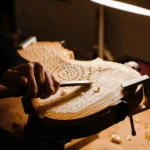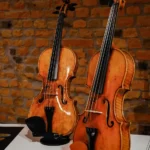Buying a violin: our top tips when looking for the best violin.
Back to BlogPlaying the violin is a challenging yet rewarding musical ability. We’re sure you’ve come across hundreds of instruments and you may be wondering what to look for when buying a violin.
Violins come in all shapes, sizes, and their own unique history. The best violin for me may not be the best one for you. To help you take some of the mystery out of buying a violin we’ve put together this blog post to give you a very brief overview of violins and how to choose one that will get you to your end goal. Here are some tips to help you along the way.
The important things to consider when buying a violin
When you think you are ready to buy a violin, you probably have two things on your mind; great sound and a suitable price. These two factors may seem contradictory; some people will tell you that the best concert violins are the most expensive. But in fact, you can find both good sound and great prices among violins made by modern and contemporary skillful makers.
There is a variety of options out there, to facilitate your search, define your budget and focus to look for violins in between your range. I’m pretty sure it will be more effective by setting up a maximum you can afford. By limiting a budget the options may decrease to half and you can completely focus on the characteristics of the ones the market has to offer for you.
When looking for an instrument, you must define an ideal sound, the type of sound you like, whether it is bright, warm, dark, etc., and to assist in this decision-making, we advise you to listen to the sound of as many instruments as possible.
Now is the time, let’s see how you can select your top 5?
1. Choose a model with the proper size for you
First, you need to know the right size for you. If you already play the violin, you will probably already understand the dimensions; if you are a student, look for help from your teacher. It is necessary to keep in mind what the right measurement for you to feel comfortable playing on it. The correct measurement will vary according to your height and your arm length.
The most common measurement is its length of back (LOB); full-size violins have their length of back varying from about 10 to 12 mm. Usually, an average a Strad model is 356 mm, instead, Guarneri’s, who used a slightly smaller shape, around 352 mm. Therefore, size varies according to the model; make sure you choose a model with the proper size for you.
2. The string length should fit correctly
Still talking about measurements, it is important to confirm that the string length is within the normal standards for the size of the violin. A string length outside the pattern will hinder playability since finger positions would change. For full-size instruments, the standard measurement should be between 325 to 330mm; make sure the string length fits correctly into the instrument and doesn’t disturb your practice.
3. The ideal tone according to its model
Buying a violin with the ideal tone may be the most important factor in selecting a violin. The result of a violin’s sound will be directly related to its model, for example, Strad models tend to have a brighter sound, while Guarneri’s a darker tone. Ensure you have your ideal sound in mind and look for a violin that will match it and answer all your requirements.
4. Watch out for the instrument’s condition and certificate
In case you are looking for an old violin, watch out for the instrument’s condition and certificate. Always ask for its condition report and its certificate of authenticity from a reliable expert. In case it is a new instrument, ask for the maker’s certificate of authenticity. Certify its authenticity.
5. Ask for help, second opinions will acknowledge your own.
If you are serious about playing the violin, many aspects of the instrument matter in the selection process. If you need help, shop for violins with someone who has a good ear and will be honest with what they hear. Also, rely on the opinions of professionals, they help musicians to find their own violin every day, I’m pretty sure they can give you the best advice out there according to your requirements.
Don’t forget that, if the instrument doesn’t feel right in terms of playability, there are many adjustments that can be easily done and are very personal for each musician. Make sure to have a professional by your side that you can trust and help you to refine your perfect match.
There’s more than meets the eye when you’re buying a violin
Using a good instrument will make a big difference not only on your skill but also on your overall enjoyment of music. You will be much more accomplished at playing the violin, and ultimately you will enjoy the music more.
Just about every violin on the planet can be played upon and will produce lovely tones, but it’s the manner in which each musician combines their own style with their violin that makes for truly unique performances.
If you are a complete beginner who is starting to learn to play the violin, or if you’re a professional looking to upgrade your instrument, the decision of choosing a violin can be quite tricky because sometimes the most expensive isn’t always the best for you, and normally the price ranges are set according to the violin’s age and the luthier behind its construction.
Shop All: Violas, Cellos, Bows
If you are not sure if it is the right time to upgrade your violin, read our blog about the signs your violin could be giving you.
Keep an eye out on our Facebook, and Instagram pages for more tips about violins!









